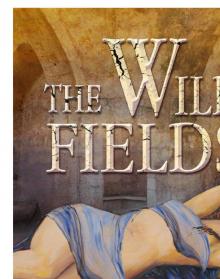- Home
- Purple Hazel
The Wild Fields
The Wild Fields Read online
THE WILD FIELDS
by
Purple Hazel
TORRID BOOKS
www.torridbooks.com
Published by
TORRID BOOKS
www.torridbooks.com
An Imprint of Whiskey Creek Press LLC
Copyright © 2018 by PURPLE HAZEL
Warning: The unauthorized reproduction or distribution of this copyrighted work is illegal. Criminal copyright infringement, including infringement without monetary gain, is investigated by the FBI and is punishable by up to 5 (five) years in federal prison and a fine of $250,000.
Names, characters and incidents depicted in this book are products of the author’s imagination or are used fictitiously. Any resemblance to actual events, locales, organizations, or persons, living or dead, is entirely coincidental and beyond the intent of the author or the publisher.
No part of this book may be reproduced or transmitted in any form or by any means, electronic or mechanical, including photocopying, recording, or by any information storage and retrieval system, without permission in writing from the publisher.
ISBN: 978-1-68299-298-2
Credits
Cover Artist: Kristian Norris
Editor: Katherine Johnson
Printed in the United States of America
WHAT THEY ARE SAYING ABOUT
Twin Paradox
Purple Hazel has hit a home run with Twin Paradox. This book has science fiction, action, sports, romance, and espionage. I found it hard to put down. I am inspired to write something myself, but first I want to finish reading another Purple Hazel book!
~ Frank Erwin, Austin
Intriguing, exciting, keeps you engrossed. Can't put it down. A must read.
~ Melody Wisely, Indianapolis
Other Books by Author Available at Torrid Books:
www.torridbooks.com
Spanish Posse Serial
Episode 1: The Gentleman and the Saloon Girl
Episode 2: The Casanova and the Cyprian
Episode 3: The Hunters and the Hunted
Episode 4: Heroes and Villains
Twin Paradox Series
Twin Paradox Book One
Twin Paradox Book Two
Twin Paradox Book Three
Morgana’s Handmade
Book 1: The Elixir of Dreams
Book 2: The Creature of the Dungeon
Table of Contents
Chapter 1: The Zasechnaya Cherta 1566
Chapter 2: Ludmilla
Chapter 3: Tatyana
Chapter 4: Hesitation
Chapter 5: Belgorod
Chapter 6: Bogdan's Tavern
Chapter 7: Father's Farm
Chapter 8: Moscow Burns
Chapter 9: Captured
Chapter 10: The Long March
Chapter 11: Caffa
Chapter 12: Slave Market
Chapter 13: Bursa
Chapter 1
The Zasechnaya Cherta, 1566
Vladimyr looked out across the Zasechnaya Cherta; a two-hundred-mile long defense line constructed out of wooden pikes, which ran along the southern frontier of the Tsardom of Russia. Out into the dikiye polya (Wild Fields) he gazed, shielding his eyes from the sun and searching the countryside to the south.
It was rather dry and cool that day, with the smells of infinite rolling grasslands and the occasional whiff of horse manure to stimulate his senses. They’d been marching all morning; and his hands were already sweating inside his big rawhide gloves which protected them from powder burns. However for the moment his unit had paused while his commander; a Russian nobleman appointed by the Tsar, allowed his troops to rest and survey the southern hills for enemy movement.
‘The Wild Fields’ was the Russian name for the wilderness between Muscovy and the no-man’s land of rolling Steppe (prairie) that separated southern Russia from the Crimea. Rich farmland abounded there, but to go down south and farm was terribly dangerous, if not downright foolhardy. As a deterrent to recurring enemy raids into Russian territory, the Great Abatis Line (Zasechnaya Cherta) was eventually constructed
Vladimyr was a member of a type of military unit called Streltsy, literally meaning “shooters,” and these meagerly trained but quite hardy border guard units had been recently created to support mounted noblemen in battle. Vladimyr’s patrol unit (or desyatki as they were called) numbered ten men and he, just like his comrades, wore a bright red great coat over his rubakha (shirt) that came down past his knees to his burnt orange rawhide boots. It was appointed with braided toggles for buttons, and he wore a red felt Shapka (hat), trimmed around the base in black fur, which kept his head protected from the harsh windy climate of the southern steppes.
Vladimyr and his comrades carried an arquebus—an early form of musket which could be mounted onto a four-foot poleax to aim and fire. They could shoot at attacking cavalry, then use their poleax in close-order combat when enemy troops closed on them. They carried a pouch with gunpowder and cartridges of lead balls for their gun; plus each soldier wore a saber sheathed in a wooden scabbard belted around their waist.
It had been a week since the Russian army had finished building this last section of the defense line and he knew any day now, they’d be coming. They’d always come this time of year…every spring…once the snow melted…once the ground had dried enough for their ponies to move swiftly. They’d show up in packs or in hordes of two hundred—maybe even ten thousand sometimes; but they’d appear on the Russian frontier ready to raid the lightly defended southern regions of the Russian kingdom.
The Zasechnaya Cherta was meant to put a stop to this, and that’s why Vladimyr subsequently had to join up. The Russian Tsar Ivan IV bankrolled the construction of it in an effort to satisfy his Boyars (nobles) who’d been clamoring for military support in the area. Vladimyr was one of the many thousands of peasant farmers conscripted into service to build it; and his unit commander, a Boyar named Vyacheslav, never needed to institute a fitness program for his troops. There was no “basic training” necessary. He simply ordered Vladimyr and his comrades to dig a massive trench and stick pikes in it with sharpened tips pointing outward; facing south.
Hundreds of work crews just like Vladimyr’s toiled day after day building this barrier, from March well into the fall. They started work when the snows first began to melt and the rains came to wash the snow away and turn the land into muddy quagmires wherever horses had trod and wherever men had marched. By October when the rains came again; and gradually turned to snow, they returned to their home villages or farms. Then the following spring they mustered their units to return to work again, digging and chopping and planting pikes year after year, until the line was finally finished.
Such rich soil, thought Vladimyr quite often while they were digging trenches for the pikes. “If only we could plant here!” he’d even mused out loud to his commander one day during construction of the barrier. “Everywhere here…the soil is so rich, my lord!” he added, grabbing a clump of dirt and grinding it apart with his fingers. Then he shook his head and went right back to digging. He wasn’t being insubordinate, just making a blunt observation. If only they could…down here where the soil was so rich…Russia could feed its people so easily. Famines would become a thing of the past, no doubt. Yet alas, few would dare risk it.
His commander Vyacheslav at the time merely grinned and gave a subtle nod. No, it didn't bother him to hear an occasional gripe or a cynical comment from his men. Soldiers would do that from time to time—it was only natural. Vladimyr was one of his best workers and completely reliable, after all. He wished he had more men like him to be honest. Vladimyr was all business, from dawn to dusk. Never complained…always set the example for other workers to follow; and not a bad shot with
his arquebus either! It was backbreaking work, digging and hauling logs then positioning and posting pikes in the ground for mile after grueling mile. Yes, Vyacheslav was lucky to have a man he could count on like Vladimyr.
Yet Vladimyr didn’t mind it so much. Farming life, in his opinion, was far worse than building an endless line of trenches and spikes. Plenty of food to eat every day; there was both a morning and an evening meal, brought to the workers from local farms or brought back by hunting parties. There was bread and cheese at lunchtime, too. Grateful Boyar families in the area sent food to their camps all along the Russian frontier; and at the end of nearly every work day the men could smell dinner cooking from a mile away. They’d be tired, oh yes, but it was quite a relief come quitting time each work day, to find a big pot of Zharkoye simmering over a campfire. The smell—to a tired crew of soldiers digging trenches all day—was downright heavenly. Zharkoye was an ancient Russian stew recipe; and it was made for them each night from wild game meat, carrots, potatoes, onions, garlic, and wild parsley or dill (whatever they could find from nearby farms and meadows). Hunting parties would bring back a freshly killed antelope every few days or so, and the butchered animal would be made into a meal for the exhausted troops.
The life of a muzhik (Russian Serf)—by way of comparison—was miserable enough to keep Vladimyr quite content with his circumstances as a border patrolman; and when others complained he was quick to remind them, “We should be happy comrades. When did we ever eat this well?” He made a very good point. On their farms, wild game or any kind of meat for that matter, was a delicacy and only available on that rare occasion when their landlord graciously provided it during Christmas. Other than that, a Russian muzhik typically existed off barley bread, cheese, and vegetable pottage. Besides, each evening when they marched back to their camp exhausted, there was also a quart of ale waiting for each of them. Vladimyr and his comrades appreciated that most of all!
By 1566, when the Zasechnaya Cherta was completed, Vladimyr was not missing farming life one bit. However, he also knew this long wall of wooden pikes was only a mild deterrent at best, and if they wanted in, they would get in somehow. In reality, they would go right around it most likely, the crafty devils. They had ways. Because these raiders from the south…they weren’t looking to just pillage rich cities or capture herds of livestock. They weren’t even looking for food. They were hunting humans.
“They” were the Crimean Tatars of the Nogai and the Wild Fields to the south of Russia was a sparsely populated area of mostly nomadic herdsmen who’d descended from the Golden Horde of the great Genghis Khan. The Wild Fields extended north of the Black Sea and the Sea of Azov, lying between the Don River to the east and the left tributaries of the Dniester River to the west. It was bounded to the north by Kiev. The territory was ruled first by the Golden Horde, then seized by the Grand Duchy of Lithuania following a rare military victory against the legendary Mongols. However, within only a few years it was retaken by Temur Qutlugh, Khan of the Golden Horde; and remained in Mongol hands for centuries.
Gradually though, as the Mongol Empire splintered the area began to be dominated by the Crimean Khanate, a political entity of the newly expanding Ottomon Empire. And it was (as Vladimyr saw it anyway) the fault of those very same Turks far across the Black Sea that the ‘slave hunts’ had begun in the first place. It was the Turks who demanded such a steady flow of new workers and servants for their empire—as well as in their harems—to work their farms and plantations or provide companionship and entertainment to their wealthy Pashas and Sultans. White slave girls from the north were especially valuable, and quite numerous enough to fulfill this need. What’s more they were not Muslim, so their masters could do with them whatever they pleased. They were not protected by the laws of the Koran. They were infidels. But best of all, they were—to the Turks anyway—quite exotic!
They had bright round eyes of blue, green, hazel, and sometimes gray, which was unique; and they had white or blonde hair (occasionally brunette or sandy gold as well). Their milky white flesh was also something so very new and exciting to the Turks. Descended from the Rus, a tribe of Scandinavians who’d migrated south during the Viking Diaspora, they were filthy peasants all of them; even if they did clean up rather well with a nice bath. Though the males were often hulking giants with brutish strength and harsh features, the females were comparatively quite beautiful on occasion. It was those pretty young females that were prized above all.
Captured males under forty—they would often be used as field hands, while the very old or very young were brutally slaughtered or simply abandoned to die whenever caught. All captives were marched south into Tatar lands and divvied up among the warriors to use as they pleased. In fact, a third of the captives taken would remain right there in the Crimea working as slaves on farms or doing domestic work for their Tatar masters. In effect, it was not much different than rounding up wild horses and breaking them into draft animals or ponies for battle; which the Tatars also did to make a living by trading them with other tribesmen. But the other two thirds would usually be taken to the infamous city of Caffa on the Crimean coast; where they’d be sold to merchant slavers for a tidy profit. There in Caffa, the men or unattractive women would be pressed into domestic duties or hard daily labor as field hands throughout the Ottoman Empire.
Abused by task masters and forced to work dawn to dusk day after day—or well into the night—they suffered in their bondage for the rest of their miserable existence, only to be kept in cages or dungeons at night (fed just enough to keep them alive until they perished). Indeed, they lived short and wretched lives—those helpless former peasants—or in some cases died at their oars working on Turkish galleys. Yet oddly enough those who expired quickly…they might very well have been considered the lucky ones. Because to a Russian captive taken by Tatars, beauty was but a curse. The beautiful girls and women taken during the raids faced an even more sinister and infelicitous fate.
The Wild Fields were traversed via several warpaths called the Muravsky, Kalmius, and Isyumsky Trails. These trails ran between Russia and the Crimea, and Tatar raiding parties knew them well. The Tatars carefully avoided fords that could be patrolled by Russian troops. Instead they took the high ground between one river basin and the next, following trail guides who would lead them into enemy territory practically undetected. Muravsky was the western route, beginning at the headwaters of the Dnieper River and extending north by northwest across the Donets River.
It eventually crossed the watershed of the Vorskla River to the east of the Belgorod area, and that coincidentally was where Vladimyr’s family made their home. His farm was there—just fifteen miles from the city, and on this very day as his comrades took a break from marching to gaze out over the Wild Fields to the south, he got a sinking feeling he might never see his home again. Not now anyway! Because something quite foreboding had grabbed his attention. Something way off in the distance…out there on the southern hills…had caught his eye.
Vladimyr looked out over the steppe, beyond the wall of wooden spikes. And that’s when he saw him. There was no doubt in Vladimyr’s mind what he was either. It was a Tatar. No one else would be out there in that no-man’s land! Besides, Vladimyr could see the big furry hat on his head, and could make out the quiver of arrows sticking up from behind his back. Tatars carried a saber into battle; and also possessed a dagger along with a ten or twelve-foot strand of rope for use in holding captives. But their most devastating weapon was their composite bow.
A Tatar bow looked different from those of western design. It was made from wood and sinew; and an arrow fired from it could cover a wider distance than the curved bow of European peasant archers. Tatars were deadly accurate with them. Their arrows could easily pierce the padded or leather armor of most lightly armored infantry. Plus, they did it all from the saddle of a speeding pony which made them even more terrifying in battle.
Tatars it seemed, just like their Mongol ancestors, practically lived
their whole lives in the saddle. They could ride and fire arrows while at full gallop, leaning forward in their saddle to compensate for their pony’s undulating gallop; or twisting sideways to deliver murderous fire at their flanks. They could even turn ‘round to fire backward over the haunches of their mount at a pursuing enemy, making it difficult to chase them without taking even more casualties. They were some of the world’s best light cavalry and earned that reputation over the centuries by teaching their craft to generation after generation of eager young men yearning to follow in their ancestors’ footsteps. They hit hard and then fled, always leaving their enemy behind and avoided getting embroiled in melee combat.
Fully engaged, they didn’t fare very well with Russian heavy cavalry, no, but that wasn’t the biggest challenge with Tatars. The real problem was in finding them. Catching them out in the open—that was the real difficulty. They were just too clever sometimes.
Vladimyr knew for instance, if that Tatar over there on that hilltop looking back at him was being seen by Vladimyr’s patrol…it was only because he WANTED to be seen. And as fellow Tatars from his band popped up around him, Vladimyr knew this was an attempt by the enemy Chieftain commanding them to spread terror and fear among Russian peasants in the area. He would get his wish, too! Vladimyr’s captain—who’d already seen the same thing—reacted quickly and rode off to a nearby signal pyre to light it and send the message: “Tatary! Oni zdes’! Podgotovit’!” The Tatars had arrived.
But was this the real attack? Or was it just another trick by the crafty Tatars to draw attention to a small portion of their actual force? It wouldn’t be the first time this had happened. Vladimyr calmly stood and studied the enemy from across the open steppe. He tried counting their numbers, while his comrades loaded their arquebuses and prepared for an engagement that was likely never to happen that day. No, the Tatars would not attack them and risk a frontal assault against flying musket balls. They didn't need to do that anyway.

 The Wild Fields
The Wild Fields Star Kitten
Star Kitten Morgana's Handmaid and the Creature of the Dungeon
Morgana's Handmaid and the Creature of the Dungeon Twin Paradox
Twin Paradox Twin Paradox_Book Two
Twin Paradox_Book Two